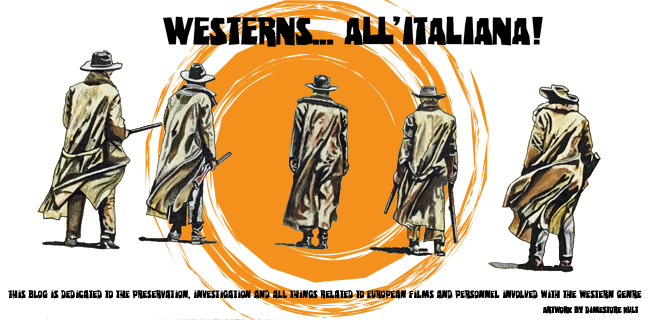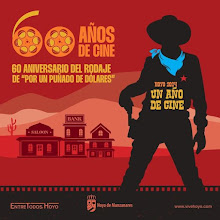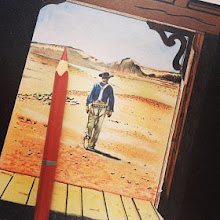Is the West the most misunderstood region in the United
States?
High Country News
By Udo Zindel
April 13, 2015
It must have started when I was seven. In a
black-and-white photo taken for “Fasnacht” — South German Mardi Gras — I’m
sporting a cowboy hat and have a bandana around my neck. This showed my fellow
Germans that I was strong and courageous, close friends with the Indians. Their
faraway home in the American West was exciting and sometimes dangerous, but I
was never afraid because the good guys always won.
Like every true German boy, I devoured Karl May’s novels
about the Wild West: the tales of Winnetou, a virtuous Apache chief, and his
Anglo-American blood brother, “Old Shatterhand.” As he was dying, Winnetou
converted to Christianity, a twist that took the story too far for me. So I
turned to the “Tecumseh” series by Fritz Steuben, the great-grandson of Baron
Steuben, who helped train Washington’s troops at Valley Forge. I was taken by
his detailed, vivid accounts of Native American life — and by the gruesome
history of a war of extermination. I quit riding with the cowboys in my
imagination and instead walked thousands of miles with the great Shawnee,
determined to forge a confederacy of tribes to fight Anglo-American
encroachment.
I kept reading as I grew older, and I watched Western
movies, from Hollywood adventures to the disillusioned, tough Italian
“spaghetti Westerns,” produced in Europe. Slowly, I realized that the romantic
American West of my childhood might have nothing in common with the place
itself.
Now, half a century and over a dozen trips later, I think
the West is the most misunderstood and disrespected region in the United
States.
I first saw the West with my own eyes in August of 1985.
I was 28 and a Fulbright exchange student at Arizona State University. As I flew from New York to Phoenix, I gazed
in fascination at the changing landscape below. Like the settlers a century
ago, I saw the green forests of the Midwest give way to prairie, then to vast,
mountainous desert pockmarked with bunchgrass, shrubs and cacti. I could hardly
contain my excitement.
For the first months, I lived in my own personal Western
movie: I was the star, a light-skinned Suebian dude who bushwhacked his way
through the labyrinths of Arizona State University and — on weekends — explored
the wild backcountry. I was stunned by the countless canyons and the
rainbow-colored deserts, by the high wooded mountains and the friendly small
towns. I had finally found my way to the Land of the Free.
The national parks became my favorite institution of
higher learning, even better than the university. There was no better place to
study Ancient Puebloan culture, for instance, than remote Keet Seel Ruin in
northern Arizona, where I stood by a knee-high dungheap left by domesticated
turkeys back in the 13th century.
But as the novelty passed, I began to see a more nuanced
West. I learned that cowboys were once called “cowpokes” and that, far from
being considered heroes, they stood at the bottom of a hierarchical society
governed by dollar bills, of which they earned bitterly few. Indians were now
Native Americans, yet they remained an often-overlooked minority who lived in
what struck me as Third World islands within the U.S. — reservations plagued by
poverty, alcoholism, domestic violence, disease and general disorientation.
Even the cityfolks in Phoenix seemed trapped in what a
friend of mine called a “godless, soulless, cultureless” place. Some
middle-class families spent $400 a month
on air conditioning and long hours every day stuck in automobiles. In the
1980s, the “Valley of the Sun” could have been one of the world’s centers for
photovoltaic and thermo-solar energy. Instead, its electricity came from Palo
Verde Nuclear Power Plant, then the world’s largest reactor complex. My own
West Germany, a country smaller than Arizona, took the lead in developing
alternative energies and making nuclear power obsolete.
Phoenix also lacked what Europeans treasure in their cities
— a vibrant, attractive center. It had copied Los Angeles’ dysfunctional model
of suburban sprawl, and its voters rejected every attempt to improve public
transport. Some scholars trace modern suburbia to Jefferson’s early-19th
century ideal of agrarian democracy — middle-class families living like small
farmers on their own little allotments, each with a bungalow, two-car garage,
lawn and pool. But after experiencing Phoenix, that theory seemed out of touch
with the desert environment.
The city planners and architects had learned nothing from
the cultures that had sustained themselves for centuries in this harsh and
fragile land. And many Arizonans derided Arcosanti, Paolo Soleri’s
architectural experiment in Paradise Valley, as a hangout for old hippies and
slackers, though I thought it embodied one of the few viable visions for
sustainability in the desert.
I left the West after my Fulbright ended, but returned
about a dozen times as a reporter for German Public Radio and as a tourist. The
more I saw, the more my feelings grew — both love and a bitter sense of
disillusionment.
Nevada was a particularly brutal teacher. In late
November 1991, I pulled off State Highway 447 in search of some peace and
quiet. I had just witnessed a demonstration of highly sophisticated software
at “Strike University,” a training facility for fighter pilots at Fallon Naval
Air Station. The clean-cut airmen showed us how they could — simultaneously —
track every move of up to three-dozen bombers and fighter planes, as they
conducted mock assaults and air battles. It was unsettling; I lost a
grandfather in World War II, and though I admired the smart young pilots, I
couldn’t help thinking of the pain and suffering their missiles and bombs would
inflict on the ground. Fallon is where fighter pilots trained for Operation
Desert Storm, and I suspected it would produce more fighters for future wars.
My well-worn Rand McNally Atlas shows military
reservations across the West: Yuma Proving Grounds, White Sands Missile Range,
Chocolate Mountain Gunnery Range, Hawthorne Army Depot, Nellis Air Force
Bombing and Gunnery Range, and the Nevada Test Site, a crater-strewn wasteland,
symbol of mankind’s ability to self-destruct. European NATO Forces, including
German soldiers, also train on these grounds — perhaps the West’s darkest
places. As the late Charles Bowden wrote in his book, Redline, “Americans hate
their deserts and consider them useful only for exercises in assault.”
After half an hour in the shade of a little cottonwood, I
turned back onto the highway, only to stop again a few miles away, drawn by a
historical marker near the Truckee River. The sign commemorated the Battle of
Pyramid Lake, fought between volunteers, a U.S. Army detachment and a band of
Paiute Indians, who were trying to cover their families’ retreat into the Black
Rock Desert. I had never even heard of it. I took pictures of the marker and
the battlefield without really knowing why.
Four years later, around Christmas, I was sitting with my
stepfather at the long table of the Tyrolian mountain farm my family has rented
for decades, when he asked out of the blue, “Does Pyramid Lake ring a bell for
you?” He had found an old suitcase filled with letters from Karl, a
long-forgotten great-grand-uncle who emigrated to the U.S. in 1847. Karl, a
soldier, fought at the Second Battle of Pyramid Lake on June 2, 1860. He
described it in a letter to his parents in Stuttgart: “I almost lost my life,
because one bullet went through my hair right over my right ear without injuring
me. I was so stunned at the moment, that I could not find a cartridge.”
Those letters reframed my relationship with the West. I
can no longer blame “Americans” alone for the darker parts of the region’s
history, because my own family’s history in the West goes back so much further
than that of most residents today. Karl was a political prisoner during
Germany’s Vormärz period, yet he fought Native Americans and helped to destroy
their culture. He did this despite his love for the Native people. In a letter
from Fortress Alcatraz, he explained why he re-enlisted with the U.S. Army:
“City life was really against my grain and I longed to be back in the
wilderness with the Indians.”
The West is full of contradictions, and I am one of them.
Cowboy hats now make me suspicious, especially in cities. They are too often
donned by people who hide their own economic and political agendas underneath
the broad brims. I have little tolerance for the modern West’s aggressive
stance against taxes and government and regulations, and its overuse of the
mythology of rugged individualism. My heroes are the people who are striving to
live sensibly and sustainably in the West, much as the one-armed explorer John
Wesley Powell advocated 140 years ago. And I hope, and believe, that their
number is growing.
On my desk at home in Germany sits a photo that keeps the
West ever-present to me. It shows a colorful sunset from Grand Canyon’s
Imperial Point, looking toward the Hopi lands; huge, lead-colored thunderheads
loom in the distance.
The picture brings back hundreds of sweet memories: of
Chicano friends in Arizona mining towns, of Native American friends at the
university, of ranchers who welcomed me into their homes. It conjures up hikes
and vistas and campsites where I encountered indescribable beauty. Around the
equinox, the sun shines through my window directly onto the photo, and its
light enlivens the colors so that the canyon seems on fire.
I’m not sure when I’ll visit again, but I know I will
return. And when I do, I’ll discover new things that will shatter and rekindle
my unquenchable romance with this extraordinary place.
Udo Zindel was born in Stuttgart, Germany. He has worked
for Southwest German Public Radio Since 1987. He spent August 1993 as a
visiting journalist with High Country News. Currently, he works as a gardener
at a former monastery on River Neckar.











No comments:
Post a Comment